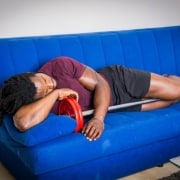What do salmon, shrimp, and flamingos have in common? They all eat the same type of algae that give them their distinctive red, orange, and pink colors. This algae contains astaxanthin, a chemical responsible for their vibrant pigmentation.
Astaxanthin is not only responsible for the striking colors in many plants and animals—especially those found in water, but it is also a powerful antioxidant. As a dietary supplement, astaxanthin offers several potential health benefits.
What is Astaxanthin?
Astaxanthin is a chemical compound known as a carotenoid. Carotenoids are colored molecules that make up the pigments in plants, algae, and photosynthetic bacteria. There are more than 750 carotenoids that come in a variety of colors like red, orange, yellow, and purple. Besides providing color, carotenoids can be strong antioxidants, filter blue light, and help cells communicate with each other.
Astaxanthin is classified as a keto-carotenoid and has an organic structure that gives plants a red color. It is naturally produced in yeast, fungi, bacteria, and the freshwater microalgae Haematococcus pluvialis. Astaxanthin builds up in algae under stressful conditions such as high salinity (salt levels), high temperature, lack of nutrients, or too much sunlight. When animals such as salmon, shrimp, and krill eat the astaxanthin-rich algae, they gain their characteristic red, orange, and pink hues.
Health Benefits of Astaxanthin
Research suggests that astaxanthin offers several potential health benefits when used as a dietary supplement. While results are not conclusive, astaxanthin has been shown to help with the following:
- Antioxidant: Astaxanthin helps neutralize free radicals—unstable molecules that can damage cells and cause health problems. By providing the missing electron, astaxanthin stabilizes free radicals, protecting cells from harm caused by pollution, smoking, UV radiation, and more.
- Skin Health: Just as astaxanthin can build up in the feathers of flamingos and the shells of shrimp, it can also accumulate in your skin. This can help give you a more even skin tone—don’t worry, it won’t turn you pink or red. Astaxanthin may protect skin from UV damage and reduce existing skin damage. Studies indicate that astaxanthin can also improve skin elasticity and moisture, reduce the appearance of wrinkles and age spots, and increase collagen fibers.
- Brain and Cognitive Function: Carotenoids like astaxanthin may also support your cognitive health as you age. Specifically, it can help support cognitive processing and memory.
- Eye Health: While astaxanthin does not filter blue light like some other carotenoids such as Lutein and Zeaxanthin, it can help reduce ocular inflammation caused by blue light exposure.
- Heart Health: As an antioxidant, astaxanthin can reduce oxidative stress (an imbalance between free radicals and antioxidants) and support a healthy inflammatory response in the cardiovascular system. This protects the heart tissue from damage and supports heart function. It also supports overall healthy cholesterol levels, including helping you to retain HDL (good) cholesterol.
- Immune System Support: Astaxanthin can stimulate the immune system by activating white blood cells (T-cells) and natural killer (NK) cells, enhancing the body’s ability to fight off infections and maintain health.
How to Incorporate Astaxanthin into your Routine
The benefits of astaxanthin have been studied in doses up to 8mg for an adult. You can consume it in foods such as shrimp, salmon, lobster, and even some fruits and vegetables.
Additionally, astaxanthin is available in various forms, including tablets, capsules, soft gels, creams, oils, powders, energy drinks, and more. Some products combine astaxanthin with other carotenoids, multivitamins, herbal extracts, and omega-3 and omega-6 fatty acids.
When taking astaxanthin as a supplement, it is recommended to consume it alongside a meal.
Are there risks to taking Astaxanthin?
If you are considering taking astaxanthin as a dietary supplement, be aware of the following potential risks:
- Medication Interactions: Astaxanthin can lower blood pressure, so consult your doctor if you are already taking blood pressure medication or other medications that may interact with astaxanthin.
- Pregnancy and Breastfeeding: There are no published studies on the effects of astaxanthin during pregnancy or breastfeeding. To avoid potential risks, consult your health professional before taking astaxanthin during these periods.
- Seafood Allergies: Since a major source of astaxanthin is seafood (such as shrimp, lobster, and krill), those with seafood allergies will need to obtain astaxanthin that doesn’t come from these sources.
Embracing the Benefits of Astaxanthin
Astaxanthin is growing in popularity as a dietary supplement due to its antioxidant properties. Incorporating astaxanthin into your routine can offer various health benefits, but it’s essential to maintain a balanced approach to health. This includes regular exercise, a nutritious diet, and consulting your doctor to ensure you’re following the best health practices.
References
https://lpi.oregonstate.edu/mic/dietary-factors/phytochemicals/carotenoids
https://en.wikipedia.org/wiki/Astaxanthin
https://examine.com/supplements/astaxanthin/?show_conditions=true
https://pmc.ncbi.nlm.nih.gov/articles/PMC3917265/
https://pmc.ncbi.nlm.nih.gov/articles/PMC7448075/
























